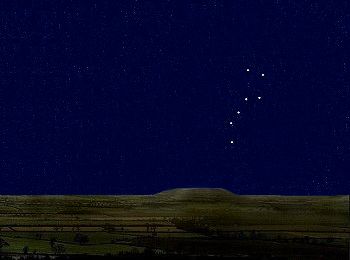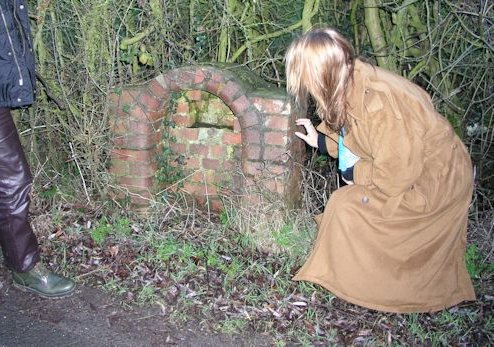Page 11 of 12
The Templars and the Ark of the Covenant
Guiding Stars

The north-east horizon as seen from the top of the Burton Dassett Hills.

The stars of the Big Dipper as they appeared on the midnight of Epiphany.

When Graham Phillips and Graham and Jodi Russell climbed to the top of the Burton Dassett Hills on the evening of January 6, 2004, they were relieved to find that there were few clouds and the Big Dipper could be seen hanging in the night sky. They stood on the summit, watching the constellation slowly moving as the earth continued to rotate until the moment of midnight arrived. The two tail stars, Benetnash and Mizar, were pointing almost vertically downwards towards the southern end of a hill that stood out in the moonlight as a stark silhouette on the far horizon.
Right: The point on the horizon determined by the line of the tail stars.

Map of the north-east Warwickshire, showing the line of sight from the Phoenix Beacon to the tiny village of Chapel Green.
When they arrived at the spot they discovered the drinking fountain all overgrown in the hedges of a roadside verge. When they saw it, they were convinced that they had cracked Jacob Cove-Jones’ code. It was a rectangular structure, about three feet high, four feet wide, and a foot thick, with a rounded arched niche in which a tap for the spring water had obviously once been set. Built from red brick, it reminded them of red-brick arch in the Epiphany Window. The star – or perhaps two stars – in the widow design was directly over a rounded brick arch that was remarkably similar to what they had found.
As they drove out to Chapel Green the following day, the three of them wondered what they would find there. In the Epiphany Window the star is shown hanging over what appears to be a chapel surrounded by a defensive wall and a red-brick, arched entrance. This was presumably meant to represent Bethlehem, but could it also represent what they were looking for? If Jacob Cove-Jones was to be believed, the place they were seeking was the hiding place of the Templars’ relics. As these items were considered holy, then the likelihood was they would have been hidden on hallowed ground. Chapel Green was named after a medieval chapel that once stood there but all that remains of it now is a holy well that stands beside a road at the foot of the hill. In fact, in the 1800s the original shrine that marked the spot was replaced by a drinking fountain that would have been there in Cove-Jones’ time. This, they decided, was the best bet.
The red-brick arch below the star in the Epiphany Window.
By flashlight, they looked at a map to see that the hill was called Napton Hill, some 14 miles to the north-east. To its immediate south was the location to which the stars had pointed – a tiny district on the edge of the village of Napton-on-the-Hill called Chapel Green.


Jodi Russell examines the Victorian red-brick arch beside the road at Chapel Green.








